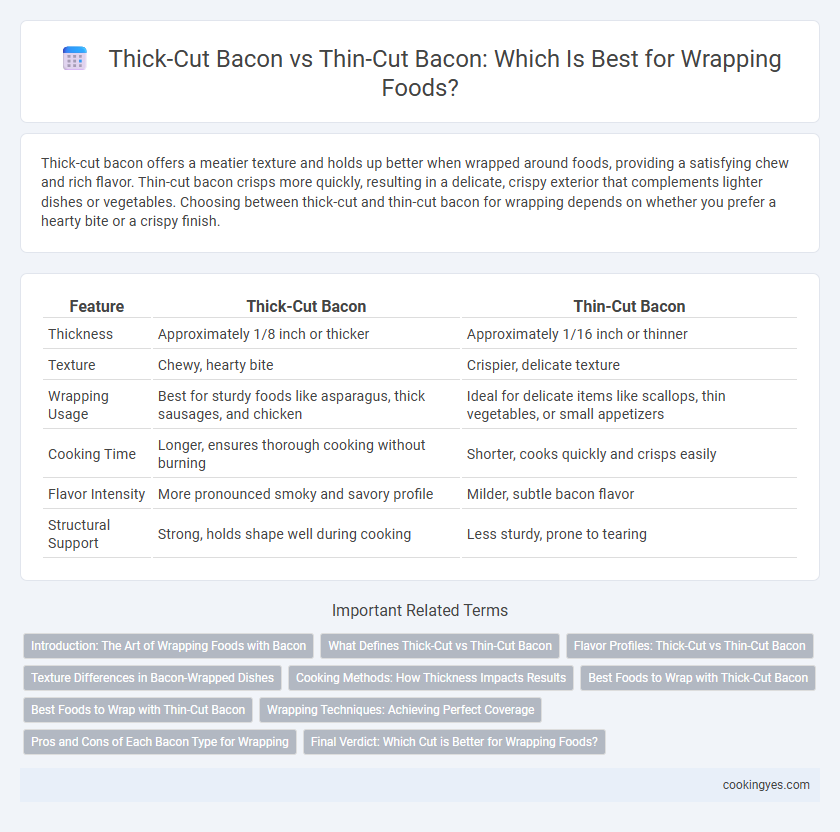Thick-cut bacon offers a meatier texture and holds up better when wrapped around foods, providing a satisfying chew and rich flavor. Thin-cut bacon crisps more quickly, resulting in a delicate, crispy exterior that complements lighter dishes or vegetables. Choosing between thick-cut and thin-cut bacon for wrapping depends on whether you prefer a hearty bite or a crispy finish.
Table of Comparison
| Feature | Thick-Cut Bacon | Thin-Cut Bacon |
|---|---|---|
| Thickness | Approximately 1/8 inch or thicker | Approximately 1/16 inch or thinner |
| Texture | Chewy, hearty bite | Crispier, delicate texture |
| Wrapping Usage | Best for sturdy foods like asparagus, thick sausages, and chicken | Ideal for delicate items like scallops, thin vegetables, or small appetizers |
| Cooking Time | Longer, ensures thorough cooking without burning | Shorter, cooks quickly and crisps easily |
| Flavor Intensity | More pronounced smoky and savory profile | Milder, subtle bacon flavor |
| Structural Support | Strong, holds shape well during cooking | Less sturdy, prone to tearing |
Introduction: The Art of Wrapping Foods with Bacon
Thick-cut bacon provides a sturdy structure and imparts a robust smoky flavor, making it ideal for securely wrapping dense foods like jalapeno poppers or chicken breasts. Thin-cut bacon crisps quickly, creating a delicate, crispy texture that complements lighter fillings such as asparagus or scallops. Choosing the right cut enhances the overall taste and ensures even cooking when wrapping foods with bacon.
What Defines Thick-Cut vs Thin-Cut Bacon
Thick-cut bacon is typically sliced between 1/8 to 1/4 inch thick, providing a meatier texture and longer cooking time, ideal for wrapping foods that require robust flavor and substantial coverage. Thin-cut bacon, usually less than 1/8 inch thick, crisps quickly and offers a delicate balance of fat and lean meat, making it suitable for wrapping delicate items or adding a subtle smoky taste. The difference in thickness directly impacts cooking methods, texture, and flavor absorption when used as a wrapping ingredient.
Flavor Profiles: Thick-Cut vs Thin-Cut Bacon
Thick-cut bacon offers a richer, meatier flavor with a satisfying chew, making it ideal for wrapping foods that benefit from a bold, smoky taste and a substantial texture. Thin-cut bacon crisps quickly, delivering a delicate, crispy bite that enhances dishes with a lighter bacon essence and a subtle balance of saltiness and smokiness. Choosing between thick-cut and thin-cut bacon depends on whether the dish requires a robust, hearty flavor or a crisp, airy finish.
Texture Differences in Bacon-Wrapped Dishes
Thick-cut bacon offers a chewier texture and robust mouthfeel, providing a substantial bite that complements hearty dishes when used for wrapping. Thin-cut bacon crisps more quickly, delivering a delicate, crispy exterior that enhances lighter, more tender foods. Choosing between thick and thin cuts directly influences the balance of textures in bacon-wrapped dishes, affecting both flavor absorption and overall eating experience.
Cooking Methods: How Thickness Impacts Results
Thick-cut bacon offers a meatier texture and retains juiciness when wrapping foods, making it ideal for slow cooking methods like baking or grilling, as it crisps evenly without burning. Thin-cut bacon cooks faster and crisps quickly, suitable for recipes requiring a delicate crunch or shorter cooking times, but it can become brittle or overcooked if exposed to prolonged heat. The thickness of bacon directly influences moisture retention, flavor intensity, and the structural integrity necessary for wrapping ingredients securely during various cooking techniques.
Best Foods to Wrap with Thick-Cut Bacon
Thick-cut bacon offers a robust, smoky flavor and a sturdy texture that holds up well when wrapping foods like jalapeno poppers, chicken breasts, and asparagus. Its substantial thickness ensures the bacon crisps without burning, providing a perfect balance of chewiness and crunch. Thick-cut bacon is ideal for recipes that require longer cooking times, making it the top choice for hearty dishes needing a flavorful, durable wrap.
Best Foods to Wrap with Thin-Cut Bacon
Thin-cut bacon offers a delicate crispiness that enhances smaller, tender foods such as scallops, asparagus, and chicken tenders without overpowering their texture. Its flexibility allows it to wrap neatly around items like jalapeno poppers and shrimp, ensuring even cooking and flavor distribution. Thin-cut bacon crisps faster, making it ideal for appetizers and dishes requiring a swift finish and a balanced smoky taste.
Wrapping Techniques: Achieving Perfect Coverage
Thick-cut bacon provides robust coverage for wrapping foods, ensuring even cooking and a juicy texture due to its substantial fat content, while thin-cut bacon offers flexibility for tightly enveloping smaller or irregularly shaped items. Achieving perfect coverage with thick-cut bacon requires layering to prevent gaps and promote thorough crisping, whereas thin-cut bacon benefits from overlapping strips to create a uniform barrier. Proper technique enhances flavor infusion and prevents exposure during cooking, whether using thick or thin slices.
Pros and Cons of Each Bacon Type for Wrapping
Thick-cut bacon offers superior structural integrity and a meatier texture, making it ideal for wrapping larger or heartier foods like chicken breasts or asparagus, but it requires longer cooking times and may render less fat. Thin-cut bacon crisps faster and provides a delicate, evenly cooked wrapper for smaller or more tender items such as scallops or asparagus, though it may tear easily and shrink significantly during cooking. Choosing between thick-cut and thin-cut bacon depends on the desired balance between crispness, cooking time, and the food's size and texture.
Final Verdict: Which Cut is Better for Wrapping Foods?
Thick-cut bacon offers superior structural integrity and a meatier texture, making it ideal for wrapping foods like asparagus or chicken breasts without tearing during cooking. Thin-cut bacon crisps more quickly, providing a delicate, crispy exterior but risks breaking apart, which may lead to uneven coverage. Choosing thick-cut bacon enhances flavor retention and ensures sturdier wrapping, resulting in a more satisfying final dish.
Thick-cut bacon vs Thin-cut bacon for wrapping foods Infographic

 cookingyes.com
cookingyes.com